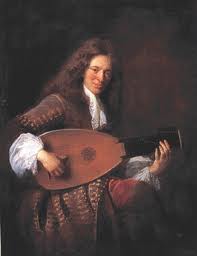Share This
Album at a Glance
Tags
Related Posts
Gaspar Sanz (1640-1710) ‘Laberintos Ingeniosos’ / Xavier Díaz-Latorre, baroque guitar
Posted by Paul Ballyk on Feb 23, 2014 in Baroque | 0 comments
Not so well known to the average classical music lover but a momentous figure to classical guitarists and aficionados of guitar music is the Aragonese composer Gaspar Sanz (c.1640-c.1710) (Aragon is an autonomous district within Spain). This recent release on the Cantus label titled 'Laberinto Ingeniosos' (Ingenious Labyrinth) is devoted entirely to the colorful and infectiously high-spirited music of Sanz. Xavier Díaz-Latorre plays the five-course baroque guitar and percussionist Pedro Estevan adds the spice with authentic percussion instruments of the Spanish baroque.
Sanz's importance to and influence upon guitarists began in 1674 when he published his 'Instruction on Music for the Spanish Guitar'; his authority has lasted to this day. A sequel was published the following year, and a third edition appeared shortly after that. These three volumes contain some ninety compositions for the instrument and are Sanz's only known contributions to the guitar repertory. Taken together with the pedagogic contents of his manuals, modern scholars have gained invaluable insights into the practice of baroque guitar performance.
The Baroque guitar of Sanz's time was strung in five courses, or pairs of strings. The lower two courses were commonly tuned in octaves and the instrument itself was tuned in fourths, which is still the practice on today's modern guitars. The music on this program was published in 1674 and 1675, a time when the guitar was attaining a status comparable to the lute. Sanz's technical methodology and his compositions themselves greatly advanced the sophistication of guitar performance. He placed more emphasis on right hand techniques - plucking rather than strumming - facilitating runs, slurs, trills and the creation of a contrapuntal texture. Together with this, his expanded use of modulation and dissonance made the music more harmonically interesting.
If you are listening to the album sample in the sidebar, you're enjoying an improvisation on a jig, Passeos por el cuarto tono. These two performers are marvelous musicians and Cantus' engineering is excellent. Overall, this is an enlightening and enjoyable glimpse of the guitar at the dawn of its time.
Between 1674 and 1675, the Spanish composer Gaspar Sanz printed a pioneering collection of pieces for the Spanish guitar. It was remarkable in many ways. First, Sanz engraved all the music plates himself, something probably necessary because there was virtually no music printing in Spain at this time. Second, Gaspar Sanz provided a huge quantity of information and instruction, including not only his entire musical output in three books printed in two years, but the most complete and useful guitar treatise of his time!
Source: Cantus-records.com
 Gasper Sanz, composer |
Gaspar Sanz Gaspar Sanz (1640–1710) was an Aragonese composer, guitarist, organist and priest born to a wealthy family in Calanda in the comarca of Bajo Aragón, Spain. He studied music, theology and philosophy at the University of Salamanca, where he was later appointed Professor of Music. He wrote three volumes of pedagogical works for the baroque guitar that form an important part of today’s classical guitar repertory and have informed modern scholars in the techniques of baroque guitar playing. |
|
Xavier Diaz-Latorre, five-course guitar |
Xavier Diaz-Latorre Xavier Díaz-Latorre was born in Barcelona, Spain in 1968. He studied at advanced level in Basle with Oscar Ghiglia at the Musikakademie and Hopkinson Smith at the Schola Cantorum. He has given concerts at major venues around the world. Díaz-Latorre performs regularly with world-renowned ensembles. Laberintos Ingeniosos is his own vocal-instrumental ensemble, which he has taken to a number of different countries throughout the world. Xavier Díaz-Latorre has made more than 30 recordings for international CD labels. |
 Pedro Estavan, purcussion |
Pedro Estevan Pedro Estevan is a Spanish percussionist, also versed in medieval music or baroque, and world music . He is a founder and member of the “Group Percussion Madrid”, and plays with many orchestras around the world. As a composer, he produced the scores of “Alesio” by I. Garcâa May and of “La Gran Sultana” by Cervantes, directed by Adolfo Marsillach. He has also worked as musical director for Lluis Pasqual’s production of “El Caballero de Olmedo” by Lope de Vega, and he has recorded the music for the film “El milagro de P. Tinto”. |
![]() About Paul Ballyk
About Paul Ballyk
all about Paul
Twitter •
| Thinking about purchasing this album?
Follow this link for more album details or to make the purchase. Buy it now |
“Not just recommended. Guaranteed.”
We stand behind every album featured on Expedition Audio. Our objective is to take the monetary risk out of music exploration. If you order this album from HBDirect.com and do not like it you can return it for a refund.
In the video, the musicians on this album perform live the final selection on the program




